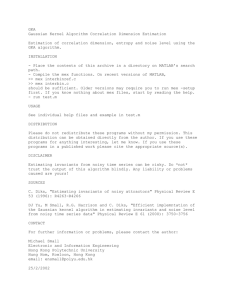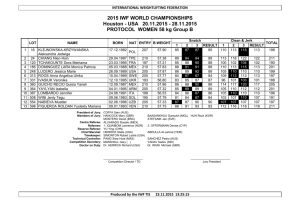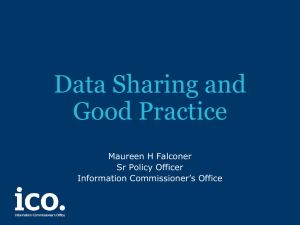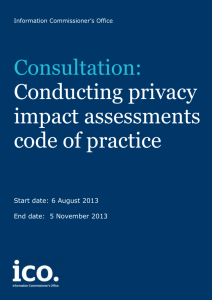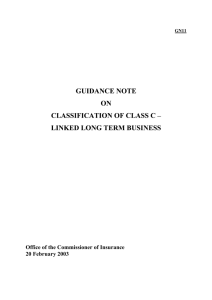IFIS - Electrical & Computer Engineering
advertisement
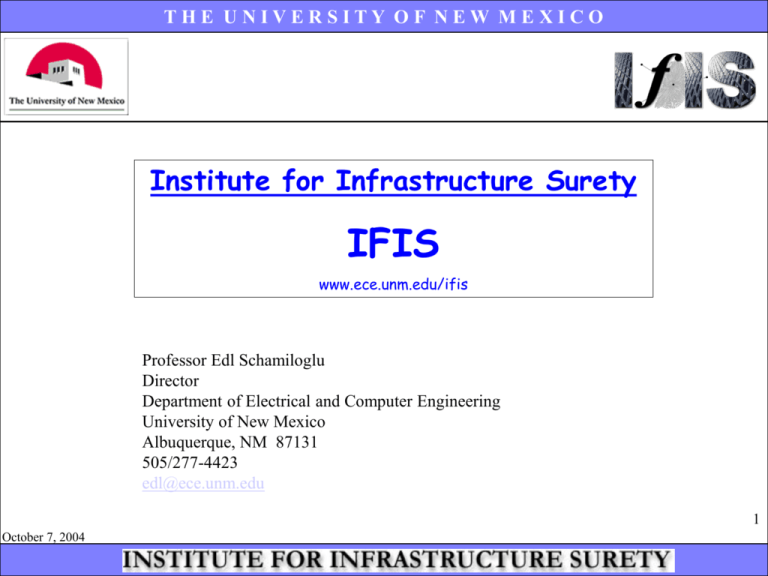
THE UNIVERSITY OF NEW MEX ICO Institute for Infrastructure Surety IFIS www.ece.unm.edu/ifis Professor Edl Schamiloglu Director Department of Electrical and Computer Engineering University of New Mexico Albuquerque, NM 87131 505/277-4423 edl@ece.unm.edu 1 October 7, 2004 THE UNIVERSITY OF NEW MEX ICO The Need for this Institute “The increasing complexity and interconnectedness of energy, telecommunications, transportation, and financial infrastructures pose new challenges for secure, reliable management and operation.1” “Complex interactive networks are omnipresent and critical to economic and social well-being.1” [1] M. Amin, “National Infrastructures as Complex Interactive Networks,” Chapter 14 in Automation, Control, and Complexity: An Integrated Approach, T. Samad and J. Weyrauch, Eds. (John Wiley and Sons, NY, 2000). 2 October 7, 2004 THE UNIVERSITY OF NEW MEX ICO The Need for this Institute • The University of New Mexico has a critical mass of creative and talented faculty and research staff that have been working on many aspects of these problems with their students for over a decade. • The University of New Mexico is unique in that, it not only has faculty and research staff that cover the breadth of research in complex interactive networks, but it also has faculty and research staff that possess depth in research into the modeling and control of networks, and several specific threats to networks. • The University of New Mexico is forming the Institute for Infrastructure Surety in order to pool its talent and resources to work on this problem that is important to the State of New Mexico, as well as the Nation. 3 October 7, 2004 THE UNIVERSITY OF NEW MEX ICO The Complex Nature of this Multidisciplinary Problem We view infrastructure surety as involving three layers: At the lowest layer, we consider specific physical threats to individual assets that might be stationary (such as a power plant that is part of a larger electric grid) or might be mobile (robotic sensors). At the middle layer, we consider communication and control within a network. At the highest layer, we consider more complex interactions, such as networks within networks. It could also involve the effects of social networks as well. 4 October 7, 2004 THE UNIVERSITY OF NEW MEX ICO The Complex Nature of this Multidisciplinary Problem Communication and Control Cascading Failure Complexity Theory/Networks Physical Threats 5 October 7, 2004 THE UNIVERSITY OF NEW MEX ICO Our Vision for the Institute The Institute was founded in the Summer 2004 by faculty in The University of New Mexico Department's of Electrical & Computer Engineering, Computer Science, Mechanical Engineering, Civil Engineering, and Mathematics & Statistics who decided to pool their talents and resources to address a shared concern: threats to the civilian infrastructure and their mitigation. 6 October 7, 2004 THE UNIVERSITY OF NEW MEX ICO Faculty Affiliated with The Institute Institute for Infrastructure Surety CS Terran Lane, Cris Moore, Jared Saia ME Herbert Tanner CE ECE Edl Schamiloglu,* Christos Christodoulou, Chaouki Abdallah, Mark Gilmore, Greg Heileman, Majeed Hayat, Scott Tyo, Mikhail Fuks, Jerald Buchenauer, David Dietz, John Gaudet Mahmoud Taha Math & Stat Vladimir Koltchinskii, Alex Stone * Acting Director, Research Faculty Institute unites experts in High Power Electromagnetics, RF Effects, Wave Chaos and Statistical EM, Complexity Theory, Communication and Control Theory, Probability Theory, and Network Analysis & Optimization October 7, 2004 7 THE UNIVERSITY OF NEW MEX ICO What Motivated us to Launch this Institute? Although we have been working on various aspects of this problem across the School of Engineering and with colleagues in Arts & Sciences, the awarding of the DTRA University Strategic Partnership Program has provided the impetus to found this Institute. 8 October 7, 2004 THE UNIVERSITY OF NEW MEX ICO 9 October 7, 2004 THE UNIVERSITY OF NEW MEX ICO 10 October 7, 2004 THE UNIVERSITY OF NEW MEX ICO Electromagnetic Attack to Systems and Critical Infrastructure* UNM •Schamiloglu (PI) •Christodoulou •Tyo •Gaudet + Giri and Tesche * Program began July 2004. NMSU •Jedlicka •Blevins (PSL) Physical Threats Electromagnetic Attack Addresses the Lowest Layer 11 October 7, 2004 THE UNIVERSITY OF NEW MEX ICO The Lowest Layer: Electromagnetic Attack – Existing University Programs in the U.S. Narrowband and UWB HPM Sources (UNM) Research: Generate higher power sources in more compact platforms; integrate with existing mobile platforms; increase pulse repetition rates http://www.ece.unm.edu/cp3/index.htm# October 7, 2004 Electromagnetic Coupling (U. Illinois) Research: Improve computational tools; explore topological models for coupling studies; more experiments on coupling; identify transfer function into systems http://www.ece.uic.edu/MURI-RF/ ComponentLevel Effects (U. MD) Research: Explore the use of chaos to affect electronics http://www.ireap.umd.edu/MURI2001/Review_14Nov03/Review_14 Nov03.htm Hardening? New UNM DTRA 12 THE UNIVERSITY OF NEW MEX ICO Collaborating Organizations (to-date): Institute for Infrastructure Surety • The University of Maryland • Air Force Research Laboratory/DEHE • Los Alamos National Laboratory • Ohio State University • New Mexico State University • Sandia National Laboratories’ NISAC (National Infrastructure Simulation Analysis Center) • New Mexico Office of Homeland Security 13 October 7, 2004 THE UNIVERSITY OF NEW MEX ICO Institute for Infrastructure Surety Sampling of Research Interests of other UNM Institute Participants: 14 October 7, 2004 THE UNIVERSITY OF NEW MEX ICO Physical Threats Professor M.M. Reda Taha, Civil Engineering Intelligent Structural Health Monitoring of Civil Infrastructures 15 October 7, 2004 THE UNIVERSITY OF NEW MEX ICO Professor M.M. Reda Taha, Civil Engineering Intelligent Damage Diagnosis Research 16 October 7, 2004 THE UNIVERSITY OF NEW MEX ICO Complexity Thy/Network. Professor Terran Lane, Computer Science The figure represents a dynamic Bayesian network model for semisupervised network intrusion detection. 17 October 7, 2004 THE UNIVERSITY OF NEW MEX ICO Professor Terran Lane, Computer Science Related Interests: • Anomaly and intrusion detection: Detecting unusual or hostile occurances in individual hosts and in distributed network systems. • Sensor fusion: Integration of knowledge from multiple, networked sensors into a holistic view of system status and environmental conditions. • Network identification: Identifying the presence and structure of causal activity networks in complex, probably nonlinear, high-dimensional data. • Methods: Machine learning; statistical decision theory; Bayesian time series modeling; relational network modeling; network structure scoring and search. 18 October 7, 2004 THE UNIVERSITY OF NEW MEX ICO Complexity Thy/Network. Professor Cris Moore, Computer Science (and Physics & Astronomy) Research Interests Relevant to IFIS: • Community structure in networks The figure represents a visualization of the community structure at maximum modularity. Some major communities have a large number of “satellite” communities connected. Highly connected nodes are more critical to a network. • Scaling of the Internet topology, computational complexity in statistical physics, social networks, and “Small Worlds.” 19 October 7, 2004 THE UNIVERSITY OF NEW MEX ICO Complexity Thy/Network. Professor Jared Saia, Computer Science Networks are Vulnerable - Many current networks are robust to random faults - However, they are not robust to adversarial faults Pre-attack October 7, 2004 Post-attack: attack deletes just 63 nodes, but the network has been shattered into a large number of small connected components. 20 THE UNIVERSITY OF NEW MEX ICO Professor Jared Saia, Computer Science Defending Networks Result: Network which will function even after massive adversarial attack - Network is robust after adversarial deletion of nodes - Network is robust after adversarial control of nodes Key Ideas: - Nodes collaborate to form robust functional units called “Supernodes” - Supernodes are connected in robust topology 21 October 7, 2004 THE UNIVERSITY OF NEW MEX ICO Communication and Control Professor Chaouki Abdallah, Electrical & Computer Engineering • Networked Control Systems: collaborative work with the University of Illinois to teleoperate networked robots. • Congestion Control: This work is in collaboration with colleagues in Europe to combine congestion controllers on the Internet with real-time controllers for robotic systems. • Distributed Computing: collaborative work with the University of Tennessee on load balancing across a network of computers. 22 October 7, 2004 THE UNIVERSITY OF NEW MEX ICO Professor Chaouki Abdallah, Electrical & Computer Engineering • Complex Networks Research: We are also interested in studying the survivability, navigability, and robustness of networked systems, especially as they relate to wireless sensor networks and networked control systems. (This work is partially funded by Sandia National Laboratories, and AFOSR.) 23 October 7, 2004 THE UNIVERSITY OF NEW MEX ICO Communication and Control Professor Majeed Hayat, Electrical & Computer Engineering c1n1 d mm un tra ica ns tio fer n/l oa Co mm un tra ica ns tio fer n/l oa Co Computing Nodes x1n1 d Node’s state c11 loa n\ tio ica r un nsfe mm tra x11 HM Co d loa n\ tio ica er un nsf mm tra Modeling and Optimization of Resource Sharing in the Presence of Large, Random Communications Delays H1 Co d Computer Hubs xM1 cM1 cMnM xMnM Computing Nodes Representative distributed-computing network. 24 October 7, 2004 THE UNIVERSITY OF NEW MEX ICO Professor Majeed Hayat, Electrical & Computer Engineering • • • • • • In mobile wireless networks, reconfigurable networks, and networks with nodes that are geographically-distant, communication and load-transfer delays play a significant role in the collective performance of heterogeneous distributed systems over such networks. Incurred delays are large and random (unpredictable). This leads to dated, unreliable knowledge of each node about the state of other nodes and the state of the network; effective autonomous resource sharing and management becomes a challenge. Key problem: Standard resource-sharing policies perform poorly (possibly catastrophically) in such random-delay-infested environments. Ongoing research funded by NSF (ITR Program): Probabilistic modeling (analytical and Monte-Carlo based), performance assessment (theoretical and experimental), and development of optimized resource-sharing policies that mitigate the adverse effects of random delay. Significant performance enhancement and robustness can be achieved. Other issues under investigation: Effects of bandwidth and node/link failure; powerusage constraints and optimization in distributed resource-sharing environments. 25 October 7, 2004 THE UNIVERSITY OF NEW MEX ICO Complexity Thy/Network. Professor Greg Heileman, Electrical & Computer Engineering The data assets that exist and are shared across complex networks in order to make them available are highly vulnerable to various threats due to this availability. These include: • Malicious destruction – network users may use their access privileges in order to modify or destroy data resources attached to the network. • Insider threat – trusted people/computers/networks that have preferential access to confidential data may apply their privileges in order to misuse the data. • Uncontrolled distribution – certain applications require the ability to distribute data or content to a select group; however, once data are provided to users, how do you prevent them from distributing the data further? The Insider Threat Problem • Applications of machine learning techniques to determine the type, level, and granularity of security to be applied in real-time to particular document objects. • Includes an investigation of the types of forensic evidence that can be inserted in order to augment security and address insider threat scenarios. • Involves categorization of content security levels from a rigorous perspective, allowing specific assurances to be made regarding software-only, hardware-assisted, and networked security solutions involving trusted third parties. 26 October 7, 2004 THE UNIVERSITY OF NEW MEX ICO Complexity Thy/Network. Professor Greg Heileman, Electrical & Computer Engineering Uncontrolled distribution • Controlling how the data assets within a networked environment are manipulated falls under the area of digital rights management (DRM), and also applies to the insider threat problem. • DRM is an emerging field attempting to address electronic distribution problems in the entertainment industry, but the technologies involved apply equally to networks supporting data belonging to corporate, government, or military entities. • As yet, the techniques/technologies capable of providing this functionality are very immature. A specific system we have developed is depicted below: 27 October 7, 2004 THE UNIVERSITY OF NEW MEX ICO Communication and Control Professor Herbert Tanner, Mechanical Engineering Biological systems inspire control algorithms for synchronization in mobile networks Networks have “natural” coordinating leaders that can be identified by studying the network topology. Leaders are critical network components that have to be safeguarded agains attacks (Group leader shown as a green circle) 28 October 7, 2004 THE UNIVERSITY OF NEW MEX ICO The Institute’s Focus is Unique i) Study Specific Physical Threats to the Civilian Infrastructure ii) Assess Vulnerability to Cascading Failure iii) Mitigate Threats TOOLS RESULTS Complexity Theory/Networks Communication and Control Mitigate Threats GOALS Physical Threats 29 October 7, 2004 THE UNIVERSITY OF NEW MEX ICO 30 October 7, 2004
